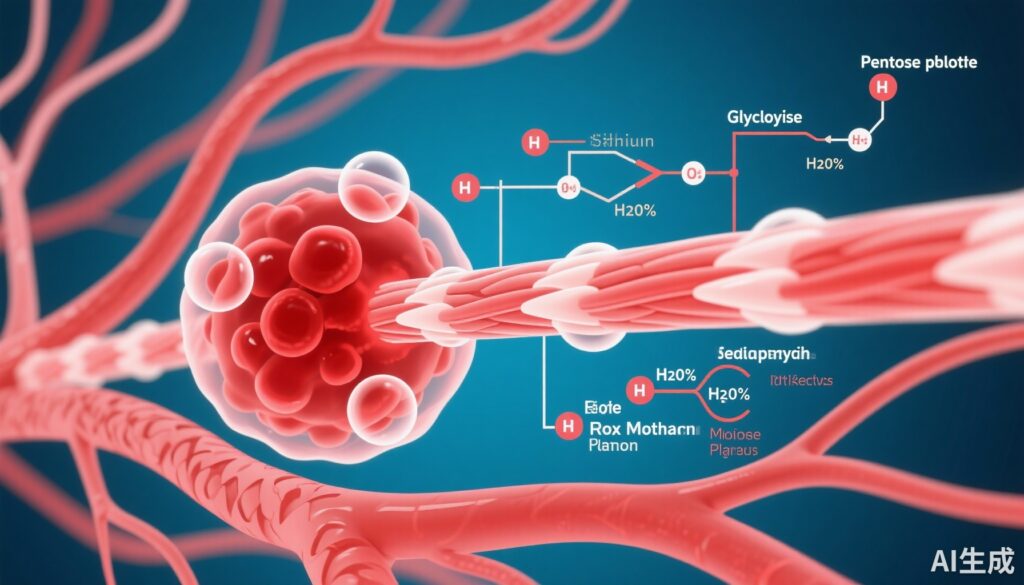Key findings
Oxidative stress markers and redox status
Following eccentric leg contractions designed to produce systemic oxidative stress, erythrocytes showed a consistent pattern of oxidative damage: F2‑isoprostanes increased by 22%, protein carbonylation rose by 28%, and reduced glutathione levels fell by ~20% compared with control. These changes indicate both lipid and protein oxidative modifications and a depletion of a primary intracellular antioxidant buffer. The observed declines in glutathione are biologically meaningful in erythrocytes, which rely on glutathione/NADPH to cope with oxidants in the plasma and within the cell.
Dynamic changes in glycolytic flux
Under oxidative stress alone (before arm exercise), erythrocyte glycolytic flux increased by approximately 53% relative to the control resting state. When participants performed isolated arm exercise, glycolytic flux rose in both experimental conditions, but with different magnitudes: in control it increased by ~200%, whereas after prior eccentric‑induced oxidative stress the increase was ~86%. The authors interpret this pattern as evidence that RBC metabolism reacts dynamically to systemic workload and oxidative challenge but that the capacity for further activation during acute exercise is attenuated after oxidative insult.
Direct ROS effects ex vivo
To probe causality, erythrocytes were exposed to exogenous hydrogen peroxide in ex vivo assays. H2O2 reduced measured glycolytic flux by ~48%, suggesting that high ROS doses can inhibit glycolytic enzymes or damage regulatory proteins, leading to diminished glycolytic throughput. Together with the in vivo observations the data suggest a biphasic or context‑dependent response: physiological oxidative signaling may upregulate glycolysis (e.g., via adaptive signaling or increased energy demand), but stronger oxidative perturbation suppresses flux by oxidative inactivation of enzymes (for example, glyceraldehyde‑3‑phosphate dehydrogenase is known to be redox‑sensitive).
Stoichiometric modeling: bioenergetic shortfall
Using a stoichiometric framework, the authors estimated that at a critical bioenergetic point during acute exercise erythrocytes produced 14.9% less ATP, NADPH, and 2,3‑BPG than their theoretical maximum. Given the central roles of ATP (cellular energy and ion pumps), NADPH (glutathione recycling), and 2,3‑BPG (modifier of hemoglobin oxygen affinity), a coordinated shortfall of this magnitude can have functional consequences: reduced 2,3‑BPG production would favor higher hemoglobin oxygen affinity (reduced unloading), lower NADPH availability undermines antioxidant defenses, and diminished ATP may impair RBC deformability and ion homeostasis—each factor can influence oxygen delivery to exercising muscle.
Effects on muscle oxygenation and exercise performance
Physiologically relevant consequences were observed: during arm exercise performed after eccentric‑induced oxidative stress, deoxygenated hemoglobin in the working arm was reduced by ~7.4% (implying either reduced oxygen extraction by muscle or altered hemoglobin unloading), and arm VO2peak fell by approximately 4%. Although modest in magnitude, these changes were consistent and biologically plausible when considered alongside the measured erythrocyte metabolic shifts.
Interpretation and mechanistic plausibility
The study supports a mechanistic chain linking systemic oxidative stress to altered erythrocyte metabolism and subsequently to changes in tissue oxygenation and performance. Mechanistically, several plausible pathways exist:
- 2,3‑BPG is produced by bisphosphoglycerate mutase as a glycolytic shunt product; lower 2,3‑BPG reduces hemoglobin P50 (increases affinity) and can limit O2 unloading at the tissue level.
- Oxidative inactivation of glycolytic enzymes (e.g., GAPDH) or damage to regulatory proteins can reduce glycolytic flux and 2,3‑BPG generation at high ROS exposures.
- Reduced NADPH compromises glutathione recycling, exacerbating oxidative damage and potentially affecting membrane integrity and deformability, which could impair microvascular transit and oxygen delivery.
- Lower intra‑erythrocytic ATP can diminish ion pump function and deformability, further affecting capillary transit and oxygen off‑loading dynamics.
Expert commentary: strengths and limitations
Strengths of this study include the randomized double‑blind crossover design, integration of in vivo, ex vivo, and computational data, and preregistration of the protocol. The use of remote eccentric contractions to generate systemic oxidative stress is a pragmatic experimental model, and the combination of biochemical markers, functional NIRS measures, and stoichiometric modeling provides a rich dataset that links molecular changes to physiological outcomes.
However, several limitations deserve emphasis when translating these findings to broader clinical or athletic contexts:
- Sample size and population: The study enrolled 20 healthy men only, limiting generalizability across sexes, ages, and clinical populations. Sex differences in redox biology and erythrocyte metabolism are established and should be addressed in future work.
- Magnitude of functional change: The observed VO2peak decrement (~4%) and change in deoxyhemoglobin (~7.4%) are modest. While statistically meaningful within this controlled setting, the clinical or performance relevance will depend on context (e.g., elite athletes, patients with limited cardiorespiratory reserve, or chronic anemia may be more affected).
- Indirect measures: The study inferred changes in 2,3‑BPG and hemoglobin oxygen affinity via stoichiometric modeling rather than direct P50 measurements. Direct assessment of 2,3‑BPG, P50, RBC deformability, and enzyme activities would strengthen causal inferences.
- Temporal dynamics: The study examines acute post‑exercise windows. It remains unclear how persistent or adaptive these RBC metabolic changes are (e.g., repeated exposures, longer recovery, or training adaptations).
- Potential confounders: Exercise induces hemodilution/plasma volume shifts and hemoconcentration effects. Although crossover design mitigates some concerns, precise accounting for plasma volume and hemolysis (free hemoglobin) would support interpretation.
Clinical and translational implications
This study reframes erythrocytes as active participants in the chain that determines oxygen delivery during exercise and potentially in disease states characterized by oxidative stress (heart failure, COPD, anemia of chronic disease, sickle cell disease). If erythrocyte metabolic responses can alter oxygen unloading, then therapeutic strategies that preserve RBC redox balance and glycolytic/PPP function may have downstream effects on tissue oxygenation and performance. Potential interventions for testing include targeted antioxidant strategies that preserve NADPH/GSH, modulators of 2,3‑BPG metabolism, and interventions that protect or restore enzyme function (e.g., agents that shield GAPDH from oxidative modification).
Future research directions
Key next steps should include:
- Replication in larger, sex‑inclusive cohorts and in patient populations (heart failure, COPD, anemia, sickle cell disease) where oxygen delivery is clinically limiting.
- Direct measurements of 2,3‑BPG, hemoglobin P50, RBC deformability, and specific glycolytic and PPP enzyme activities at baseline and after oxidative challenges.
- Longitudinal studies assessing whether repeated exposures (training) elicit adaptive RBC metabolic responses that alter performance or improve redox resilience.
- Interventional trials testing whether antioxidant strategies, metabolic modulators, or nutritional interventions can preserve RBC bioenergetics and improve muscle oxygenation and performance.
Conclusion
Chatzinikolaou et al. provide compelling integrative evidence that erythrocyte glycolytic and redox metabolism responds dynamically to exercise and systemic oxidative stress, and that these metabolic perturbations can measurably affect muscle oxygenation and short‑term exercise performance. While functional effects reported here are modest, the mechanistic linkage is biologically plausible and opens a new avenue for research and potential therapeutic targeting: preserving erythrocyte metabolic integrity may be an underexplored means to optimize oxygen delivery in health, athletic performance, and disease.
Funding and registration
The study protocol was preregistered on the Open Science Framework: https://osf.io/ub6zs. Funding sources are reported in the original publication (see reference below).
Reference
Chatzinikolaou PN, Margaritelis NV, Paschalis V, Theodorou AA, Moushi E, Vrabas IS, Kyparos A, Fatouros IG, D’Alessandro A, Nikolaidis MG. Erythrocyte Glycolytic and Redox Metabolism Affects Muscle Oxygenation and Exercise Performance: A Randomized Double‑Blind Crossover Study in Men. Sports Med. 2025 Jul 28. doi: 10.1007/s40279-025-02279-2. Epub ahead of print. PMID: 40719977.



